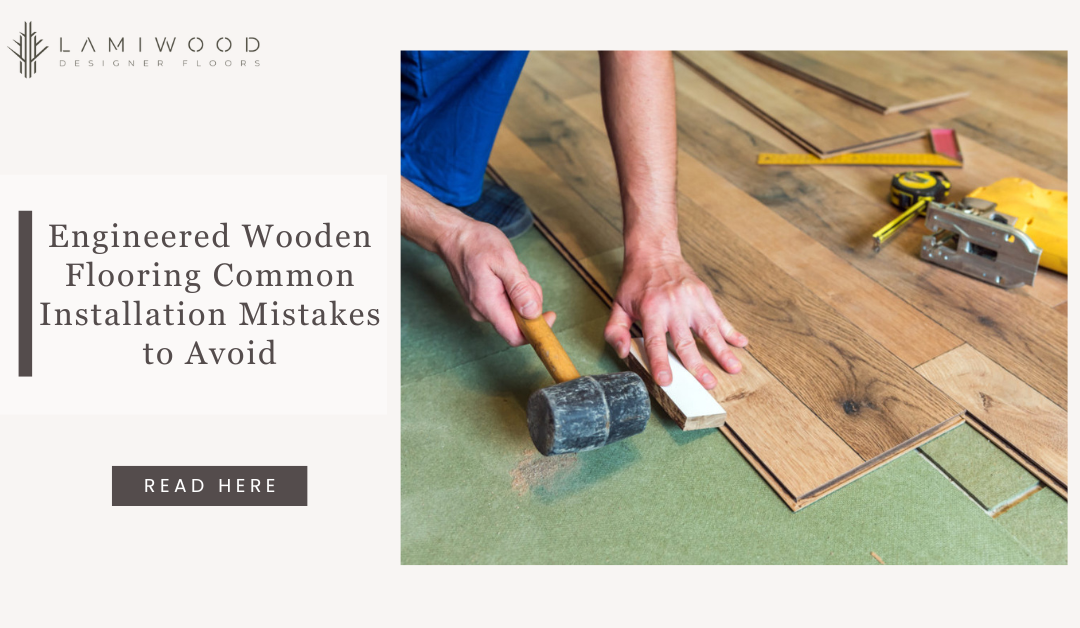Engineered wooden flooring has become a popular choice among homeowners and contractors due to its stability, durability, and versatile design options. However, even with its many benefits, engineered wooden flooring is not immune to installation mistakes that can compromise its appearance, performance, and longevity. Let’s discuss some of the most common installation mistakes and guide how to avoid them, ensuring a successful and long-lasting engineered wood flooring installation.
Common Installation Mistakes and How to Avoid Them
- Inadequate Subfloor Preparation
One of the most critical steps in installing engineered wooden flooring is properly preparing the subfloor. Failing to ensure that the subfloor is clean, dry, level, and structurally sound can lead to a host of problems, including unevenness, gaps, and premature wear. To avoid these issues, take the time to thoroughly inspect the subfloor and address any imperfections before beginning the installation. This may involve filling cracks, sanding high spots, or applying a self-leveling compound to achieve a smooth, even surface.
- Skipping the Acclimation Process
Acclimation is the process of allowing the engineered wooden flooring to adjust to the temperature and humidity levels of the installation site before installation. Skipping this crucial step can result in the flooring expanding, contracting, or warping after installation, leading to gaps, buckling, or other damage. To avoid these problems, always follow the manufacturer’s guidelines for acclimation, which typically involve storing the flooring in the installation space for a specified period (usually 48-72 hours) before beginning the installation.
- Insufficient Expansion Gaps
Engineered wooden flooring, like all wood products, expands and contracts with changes in temperature and humidity. Failing to leave adequate expansion gaps around the perimeter of the room and any fixed objects (e.g., doorways, fireplaces, or cabinets) can cause the flooring to buckle, warp, or lift as it expands. To avoid these issues, use spacers to maintain consistent expansion gaps (typically 1/4″ to 1/2″) during installation, and cover the gaps with moldings or trim pieces once the installation is complete.
- Improper Fastening Methods
Using the wrong fastening method or improperly securing the wooden flooring can lead to movement, gaps, or squeaks. The appropriate fastening method will depend on the specific product and subfloor type, so always refer to the manufacturer’s installation instructions. Common fastening methods include glue-down, nail-down, and floating (click-lock) installations. When using a glue-down method, ensure that the adhesive is applied evenly and that the planks are firmly pressed into place. For nail-down installations, use the recommended nail size and spacing, and avoid nailing too close to the edges of the planks to prevent splitting. Floating installations require no adhesive or nails, but it’s essential to ensure that the click-lock mechanism is properly engaged and that the planks are tightly fitted together.
- Inadequate Subfloor Moisture Protection
Moisture is one of the primary enemies of engineered wooden flooring, and failing to protect the subfloor from moisture can lead to warping, cupping, or delamination of the flooring. To avoid moisture-related issues, always test the subfloor’s moisture content before installation and ensure that it falls within the manufacturer’s acceptable range. If necessary, install a moisture barrier (such as a vapor retarder or underlayment) to prevent moisture from seeping into the flooring from below. In areas prone to high humidity or potential water exposure (e.g., bathrooms or kitchens), consider using a waterproof or water-resistant engineered wooden flooring product.
- Ignoring Manufacturer’s Guidelines
Each engineered wooden flooring product has its specific installation requirements, and ignoring the manufacturer’s guidelines can result in a subpar installation and potential damage to the flooring. Before beginning the installation, carefully read and follow the manufacturer’s instructions regarding subfloor preparation, acclimation, fastening methods, expansion gaps, and any other specific requirements. If in doubt, consult with the manufacturer or a professional installer to ensure that you are following the correct procedures for your particular product.
- Failing to Protect the Flooring During and After Installation
Engineered wooden flooring can be damaged by excessive foot traffic, heavy furniture, or sharp objects during and immediately after installation. To avoid scratches, dents, or other damage, take steps to protect the flooring during the installation process. This may involve using protective sheets or cardboard to cover the flooring when moving tools or materials and avoiding walking on the newly installed flooring for at least 24 hours after installation. Once the installation is complete, use felt pads under furniture legs, place mats at entryways, and avoid wearing high heels or cleats on the flooring to minimize the risk of damage.
Conclusion
Avoiding common installation mistakes is essential for ensuring the long-term performance and beauty of your engineered wooden flooring. By properly preparing the subfloor, allowing for acclimation, leaving adequate expansion gaps, using the correct fastening methods, protecting against moisture, following the manufacturer’s guidelines, and safeguarding the flooring during and after installation, you can minimize the risk of issues and enjoy a successful, long-lasting engineered wooden flooring installation. If you are unsure about any aspect of the installation process, don’t hesitate to consult with a professional installer or the flooring manufacturer for guidance and support. With the right approach and attention to detail, your engineered wooden flooring will provide a beautiful, durable, and stable foundation for your home for years to come.

